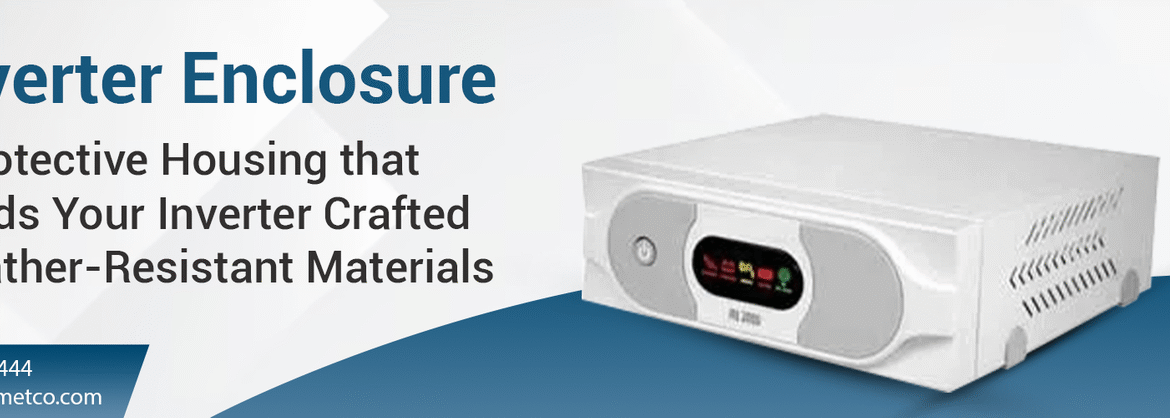An inverter enclosure is a protective housing that safeguards your inverter from environmental factors, hazards, and theft. Crafted from weather-resistant materials like aluminium or plastic, these enclosures shield the inverter from rain, dust, extreme temperatures, and physical damage. So now in this blog, you will get to know about the type of inverter enclosures and their features.
Some Different Types of Inverter Enclosures!
Inverter enclosures come in various types to suit different needs. Outdoor enclosures are built to withstand harsh weather conditions, often made from durable materials like aluminium or stainless steel. Indoor enclosures, typically made from plastic or metal, protect inverters from dust and other indoor contaminants. Wall-mount enclosures are space-saving options suitable for both indoor and outdoor use. Rack-mount enclosures, designed for server rooms or data centres, offer standardized mounting for multiple devices. Each type provides varying levels of protection, noise reduction, and aesthetic appeal, ensuring the optimal environment for your inverter’s operation.
Customization Options for Inverter Enclosures
Inverter enclosure customization offers a high degree of flexibility. Material selection extends beyond standard options to include stainless steel for durability, polycarbonate for transparency, and fiberglass-reinforced plastic for strength. Enclosures can be tailored to precise dimensions and shapes to accommodate specific equipment and installation requirements. Aesthetic preferences can be met with a variety of colours, textures, and even branding elements. To ensure optimal performance, ventilation options such as vented panels and fans can be incorporated. Security features including different door styles, locking mechanisms, and cable management solutions are available. Mounting flexibility allows for wall, rack, or floor installation, while additional features like integrated displays, solar panel integration, and battery compartments can enhance functionality.
Comprehensive Guide to Inverter Enclosure Installation and Maintenance
Installation
- Site Selection:
- Choose a well-ventilated area, away from direct sunlight and moisture.
- Ensure the location is accessible for maintenance and inspection.
- Consider the weight of the enclosure and inverter when selecting the installation site.
- Foundation Preparation:
- Prepare a level and sturdy foundation for the enclosure.
- If required, use concrete or metal stands to elevate the enclosure for better ventilation.
- Mounting the Enclosure:
- Follow the manufacturer’s instructions for mounting the enclosure.
- Ensure the enclosure is securely fastened to the foundation.
- Check for any gaps or openings that might compromise the enclosure’s integrity.
- Inverter Installation:
- Install the inverter inside the enclosure as per the manufacturer’s guidelines.
- Secure the inverter to prevent movement during operation.
- Connect the inverter to the battery bank and load according to the wiring diagram.
- Cable Entry: Use cable glands or sealing compounds to prevent moisture and dust from entering the enclosure through cable entry points.
- Ventilation: Ensure proper ventilation within the enclosure. Check for any obstructions that might hinder airflow.
- Earthing: Connect the enclosure to the earth’s ground to protect against electrical shocks.
Maintenance
- Regular Inspection:
- Inspect the enclosure and inverter regularly for any signs of damage, corrosion, or overheating.
- Check for loose connections, damaged cables, or worn-out components.
- Cleaning:
- Keep the enclosure clean by removing dust and debris.
- Use a soft cloth and mild cleaning solution.
- Avoid using harsh chemicals or water directly on the enclosure or inverter.
- Ventilation: Ensure proper ventilation by keeping vents and air filters clean. Check for obstructions that might hinder airflow.
- Temperature Control: Monitor the internal temperature of the enclosure. If the temperature exceeds the recommended limits, improve ventilation or consider additional cooling measures.
- Battery Maintenance: Regularly check the battery bank for signs of sulfation, corrosion, or low electrolyte levels. Follow the battery manufacturer’s maintenance guidelines.
- Electrical Connections: Periodically inspect and tighten all electrical connections. Check for any signs of overheating or arcing.
- Software Updates: Update the inverter’s software to the latest version to benefit from improved performance and bug fixes.
Conclusion
Investing in a suitable inverter enclosure is crucial for protecting your inverter and ensuring its optimal performance. By carefully considering the type of enclosure that best suits your needs, customizing it to your specific requirements, and following proper installation and maintenance practices, you can extend the lifespan of your inverter and enjoy an uninterrupted power supply. Remember, a well-protected inverter is a reliable investment in your home or business.
FAQs
Can you enclose a solar inverter?
Enclosing a solar inverter is generally not recommended. While it might seem protective, fully enclosing an inverter can lead to overheating due to trapped heat and restricted airflow. This can damage the inverter, void warranties, and even pose a fire risk. If protection is necessary, consider ventilated enclosures, partial enclosures, or inverter covers that allow for proper airflow. Always prioritize ventilation and consult the inverter manufacturer’s guidelines for optimal installation and performance.
Can an inverter be stored in a cupboard?
Storing an inverter in a cupboard is generally not advisable. Inverters generate heat during operation, and they require proper ventilation to function efficiently and safely. A cupboard can trap this heat, leading to overheating, reduced performance, and potentially damaging the inverter. It’s crucial to place the inverter in a well-ventilated area to ensure its longevity and optimal performance.

